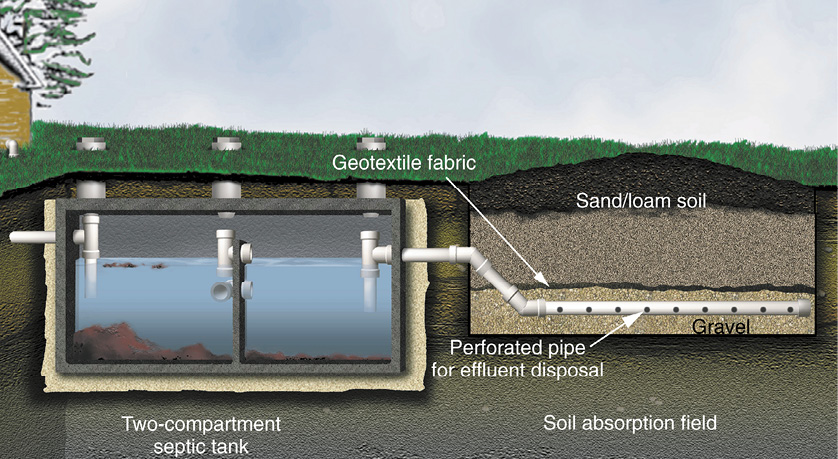Managing Household Wastewater
A properly installed and maintained system to treat and dispose of household wastewater reduces the impact of the system on groundwater and surface water. State and local codes specify how wastewater systems must be designed, installed, and maintained. The Mississippi State Department of Health’s Division of On-Site Wastewater regulates private on-site wastewater systems. Regulations include minimum distances wastewater systems must be from private wells or other water sources.
At a minimum, always follow the codes. You should also consider whether the minimum requirements are sufficient for your site. It is to your advantage to locate your septic system as far as possible from wells or other water sources.
Do not wait for the system to fail before pumping the septic tank. Once a system fails, it is too late to pump the tank.
Septic Tank/Soil Absorption System
The most common form of household wastewater treatment is a septic tank with a leach line to allow the liquid to soak into the soil (Figure 1).

In this system, wastewater flows from the household sewer into an underground septic tank. The system works basically as follows:
- The waste components separate—the heavier solids (sludge) settle to the bottom, and the grease and fatty solids (scum) float to the top.
- Beneficial bacteria break down and decompose the harmful bacteria in the system and turn them into a liquid form.
- Baffles in the tank make sure solids stay in the tank and prevent the inlet or outlet from plugging. They also slow the flow of wastewater through the tank for better wastewater treatment.
- The liquid portion (called effluent, which flows out of your septic tank) flows through an outlet to the soil absorption field, leach line, or drain field.
- The absorption field or drain field is usually a series of parallel trenches (fingers), each containing a distribution pipe of 3 to 4 inches in diameter. The drain field is then covered with gravel or rock, a moisture barrier, and soil.
- The effluent leaks through holes in the pipe, then down through the drain field gravel or rock, and then into the soil under the drain field.
- The soil filters out remaining solids, disease-causing microorganisms, and dissolved substances. The treated effluent then moves slowly through the soil down to groundwater to be recycled again.
Can My Septic System Contaminate My Well?
If your septic tank effluent flows into an area with a shallow water table, it might not be adequately purified before entering groundwater. A similar problem can happen where the soil is too thin over rock or some other dense layer to treat the septic tank effluent adequately. If inadequately treated septic tank effluent enters groundwater, your well water supply and that of others nearby can be contaminated. In this case, you might unintentionally “recycle” this poorly treated effluent into your home with your drinking water. With proper safeguards, recycling untreated sewage can be avoided.
Reducing the volume of water entering the system will improve wastewater treatment by increasing the time the waste spends in the system. This provides more time for settling and aeration, and for effluent to soak into the soil. This is especially critical in heavy clay soil.
Location of the System
Location is one of the most important parts of your design. Locate the system downhill and at least 100 feet from any drinking water source. If an existing system is closer than 100 feet to a well, it does not mean the water source is being contaminated. However, it is important that the system be properly maintained to avoid contamination problems.
Knowing the location of an existing septic tank system is important. A drawing that shows the system in relation to your house and barn is recommended.
Tree roots can enter septic system lines and cause plugging. Lines should not be placed near trees, and trees should not be planted near lines.
Maintaining Your System
The most common maintenance is to have the septic tank pumped out routinely. This is done to keep the sludge and scum from building up to the point that they flow into the absorption field and plug up the pipe and gravel bed. Most systems should be pumped out every 4 to 6 years. This time can be shorter if there is a lot of wastewater produced in the household, and especially if a garbage disposal is used. Refer to Table 1 for approximate duration between pumping and/or inspection of your septic tank.
It is important to keep a record of pump-out dates to be sure it is performed on a routine basis to avoid problems. When an absorption field becomes plugged, it may be difficult to repair.
Prevention is your best option.
Damage to the septic tank and absorption field can occur if vehicles and farm equipment are driven over the system. No driveways, concrete surfaces, or asphalt should be installed over septic tanks or absorption fields.
If you notice sewage surfacing above the absorption field, do not try to correct the problem by placing more soil in this area. This does not correct the problem, and it will reoccur in a matter of time. To correct the problem, a licensed contractor must rebuild the system.
If you suspect tree roots have clogged a drain line, they probably have to be removed mechanically. This requires a plumber with specialized equipment. After roots are cleaned out, it may be possible to discourage regrowth by periodically adding copper sulfate to the affected drain line. The copper sulfate label may have a dosage recommendation. If not, contact the county health department for recommendations. A more permanent solution is to remove the problem trees.
|
Household size (number of people) |
|||||||||
|---|---|---|---|---|---|---|---|---|---|
|
|
1 |
2 |
3 |
4 |
5 |
6 |
7 |
8 |
9+ |
|
Tank size (gal) |
Duration (years) between pumping and/or inspections |
||||||||
|
500 |
5.8 |
2.6 |
1.5 |
1 |
0.7 |
0.4 |
0.3 |
0.2 |
0.1 |
|
750 |
9.1 |
4.2 |
2.6 |
1.8 |
1.3 |
1 |
0.7 |
0.6 |
0.4 |
|
900 |
11 |
5.2 |
3.3 |
2.3 |
1.7 |
1.3 |
1 |
0.8 |
0.7 |
|
1000 |
12.4 |
5.9 |
3.7 |
2.6 |
2 |
1.5 |
1.2 |
1 |
0.8 |
|
1250 |
15.6 |
7.5 |
4.8 |
3.4 |
2.6 |
2 |
1.7 |
1.4 |
1.2 |
|
1500 |
18.9 |
9.1 |
5.9 |
4.2 |
3.3 |
2.6 |
2.1 |
1.8 |
1.5 |
|
1750 |
22.1 |
10.7 |
6.9 |
5 |
3.9 |
3.1 |
2.6 |
2.2 |
1.9 |
|
2000 |
25.4 |
12.4 |
8.1 |
5.9 |
4.5 |
3.7 |
3.1 |
2.6 |
2.2 |
|
2250 |
28.6 |
14 |
9.1 |
6.7 |
5.2 |
4.2 |
3.5 |
3 |
2.6 |
|
2500 |
31.9 |
15.6 |
10.2 |
7.5 |
5.9 |
4.8 |
4 |
3.5 |
3 |
Source: http://cartrightsplumbingandseptic.com
Limiting Household Wastewater
Reducing the amount of wastewater entering your treatment system is important because less flow means less chance of overloading the system, better treatment of the waste, and longer life of your system. Reducing the amount of water entering your system improves the treatment by increasing the time the waste spends in the system. This also provides more time for settling, decomposition of the waste, and soaking into the absorption field.
The amount of water used depends on the number of people using the system, how water is used, and the condition of the water supply system in your home.
Consider the following ways to minimize water use:
- Eliminate nonessential uses, such as flushing toilets to dispose of tissues or other wastes that should be handled as solid waste. Turn off the water between uses, and repair plumbing fixture leaks.
- Consider which actions use the most water. Toilet flushing usually ranks highest. Low-flow models could reduce water use by more than half. Placing a brick or a half gallon milk jug full of water in the toilet tank reduces the water required to fill the tank and the amount of wastewater entering your septic system.
- Bathing and clothes-washing are next in order of water use. For bathing, consider installing low-flow or controlled-flow showerheads, which give good cleansing with less water. Taking shorter showers and running less water in the tub may seem minor, but they don’t require any purchases—only changes in your habits.
- For washing clothes, use a suds saver and run full loads. When running small loads, be sure to use the reduced-water-level setting.
- In hard-water areas, the softener may be a significant user of water. Properly adjusting and timing the softener’s regeneration mechanism can reduce excessive water use.
- Keeping your family aware of the amount of water each uses and how each can reduce the amount used is as important as using water conservation devices.
Reducing Unnecessary Solids
Reducing solids entering the septic system can extend the time between pump-outs and avoid other problems with the system.
Consider the following to reduce solids in household wastewater:
- Minimize use of the food waste disposal. Disposal use contributes a large load of suspended solids and organic matter to wastewater, and it uses additional water.
- Do not put items down drains that may clog septic tanks, such as fats, grease, coffee grounds, paper towels, sanitary napkins, tampons, or disposable diapers.
- Do not put toxic substances (such as solvents, degreasers, acids, oils, paints, disinfectants, or pesticides) in drains. This does not include using bleach to disinfect laundry or washing clothing worn by pesticide handlers. Normal household cleaning chemicals and occasional use of drain cleaners should not affect the system.
- Do not use chemicals to clean or “sweeten” your system. There is no real evidence these products improve the septic system operation.
Collecting Wastewater
Wastewater generated in the household must be treated by a septic system or other approved systems, but be sure you’re not allowing water that does not need to be treated to flow into your septic tank. For example, do not let water from basement floor drain sump pumps, foundation drains, rainwater, or roof drainage to add to your septic system flow. This will keep your septic system operating more efficiently with less maintenance.
Alternatives to Septic Systems
The following systems are approved alternatives to septic systems in Mississippi.
- Aerobic (oxygen-using) biological systems (packaged systems) provide more extensive treatment of wastewater than do the typical anaerobic (no oxygen) septic units. These systems improve solids separation, release volatile chemicals, and reduce sludge volume. They are, however, more expensive to operate and maintain and are more subject to problems caused by changes in wastewater quality or environmental conditions.
- Holding tanks or lagoons may be used to collect and hold the entire wastewater flow. Disposal is generally done by a licensed contractor who dispenses the waste at an approved site or hauls it to a municipal waste-treatment facility. Tank size should allow for ample capacity to accommodate pumpage and disposal at convenient and appropriate times. When pumped, the tank should be checked for leaks.
If you need advice on alternative wastewater treatment systems or if you want to explore experimental systems, contact the Mississippi State Department of Health’s Division of On-Site Wastewater, 805 South Wheatley Street, Suite 340, Ridgeland, Mississippi 39157.
Definitions
Absorption field: The system for the final treatment of the septic tank effluent and return of the treated wastewater to the water cycle. The leaching system includes the lateral lines or sewage disposal line, the perforated pipes, the rock material, and the leaching trenches.
Effluent: The liquid discharge from a septic tank or other treatment tank.
Scum: The accumulated floating material, including grease, fats, and other light solids, in a septic tank.
Septic tank: A single tank or series of tanks in which two processes take place: settling of solids and the digestion of some of the accumulated solids.
Sewage: Used water and solids that flow to a septic tank or a city treatment plant. The preferred term is wastewater.
Sludge: Settled solids that have separated from the liquid in a septic tank.
For More Information
U.S. Environmental Protection Agency
Design Manual: On-Site Wastewater Treatment and Disposal Systems. 1980. U.S. Environmental Protection Agency. EPA Technology Transfer 625/1-80-012. (2) 391 pages. Contains information on site evaluation procedures, wastewater characteristics, on-site treatment and disposal methods, and management of on-site systems.
Septic system regulations and installation guidelines:
Mississippi State Department of Health
Division of On-Site Wastewater
msdh.ms.gov
(601) 991-6030
or
or
A licensed installer
Questions about your water quality:
or
For other information about your septic system or water quality, contact your county MSU Extension office.
The information given here is for educational purposes only. References to commercial products, trade names, or suppliers are made with the understanding that no endorsement is implied and that no discrimination against other products or suppliers is intended.
Publication 1871 (POD-01-22)
By Jason R. Barrett, PhD, Associate Extension Professor, Water Resources Research Institute.
The Mississippi State University Extension Service is working to ensure all web content is accessible to all users. If you need assistance accessing any of our content, please email the webteam or call 662-325-2262.




